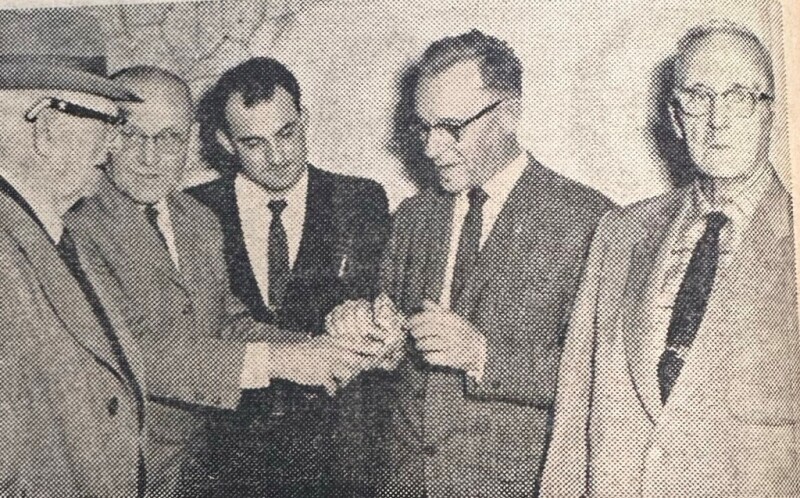Maine- Mass. Lobster Associations Move to Restrict Offshore Fishery by Mike Brown
Featured in the July 1963 National Fisherman combined with Maine Coast Fisherman
Lobstermen and officials representing Maine and Massachusetts met here recently to discuss the problems concerning the offshore fishing of lobsters and to determine what action should be taken to prevent harvesting "berried" lobsters from the fishing grounds outside territorial limits.
Present at the meeting were Leslie Dyer, president of the Maine Lobstermen's Association, and Frank Moore, president of the Massachusetts Lobstermen's Association. Robert Barlow, secretary-treasurer of the Mass. Lobstermen's Association and member of the Governor's Marine Advisory Council, as well as three lobster dealers from the Rockland area, Harold Look, A.C. McLoon, and William Burge.
The offshore lobster fishing is centered around three ports in Massachusetts: New Bedford, Sandwich, and Plymouth. Boats engaged in fishing for lobsters from these and other ports are medium draggers. Their net tonnage is about 85 tons. Moore said there are about 18 draggers now fishing out of Massachusetts, employing about 90 men.
It was reported that the draggers land over 1,250,000 pounds of lobster a year. Some 90 boats bring in another million pounds for finfish, which occasionally catch lobsters. A spokesman said, "The total value of the offshore lobsters landed will conservatively add up to $1 million annually."
No Maximum
Unlike Maine, Massachusetts has no maximum gauge law, and according to Moore, some of the lobsters harvested by these draggers range up into the 35-pound class.
"These are your prime egg bearers," Moore said. He cited a case in Massachusetts where a diver viewed 40 egg-bearing lobsters in one group. This same group of lobsters contained only one male.
Moore said it was illegal in Massachusetts to retain "eggers," but the practice existed.
He presented a lobster tail with black marks. Moore said he believed these marks were made by a lobster vice used to hold the egg-bearing lobsters while the eggs were being washed off with water or compressed air. He added that the marks were not visible until the lobster was cooked.
The egg-bearing lobster carries her eggs attached to her swimmerets and fine hairs beneath her tail. Mating takes place only just after the female has shed her shell, and it isn't until 10 months later the egg passes from the ovaries and is placed under the female's tail. They will stay here for another year, so the period of time from mating until the eggs hatch is about two years.
Moore said the inshore pot haulers in Massachusetts are finding fewer and fewer of these berried lobsters.
Tests Cited
Harold Look, a veteran lobster dealer, said the contention that the offshore and inshore lobsters are a different breed is "a bunch of baloney." He said controlled tests with offshore eggs hatched and grown over a period of years show that they grow to be the same lobster as those found inshore. Look also declared that the counter-clockwise current carries eggs and lobster fry from these "jumbo" seeders to the inshore waters.
Moore said that the majority of the Massachusetts fishermen, of whom 1200 are commercial lobstermen and 3190 lobster license holders, are gravely concerned about the future of the lobster if these illegal practices and harvesting of jumbos are continued.
He said many of the license holders are "table fishermen" and that they were also concerned.
"One of them," Moore said, "didn't know if he caught 11 or 12 last year, but he expressed his willingness to contribute financially to any because that would protect the lobster industry."
Moore continued that more than 70 million pounds of lobster come from northeastern North America and Newfoundland annually and that this multi-million-dollar business was in jeopardy unless certain steps were taken.
Plan Moves
The Massachusetts delegation said they must seek some double-gauge law in Massachusetts for a stopgap and then plug for a national and international double-gauge. They thought the United Nations might be a possible route to international legislation.
Dyer said this was a distinct possibility because nations fishing in international waters had adopted international laws concerning mesh sizes for fish. The Bay State men say the problem is complex because this offshore fishing is beyond the three-mile territorial limit, and law enforcement agencies cannot pursue or board at sea
Moore said that another problem they encounter is selling parts of lobsters, such as tails and claws, from some of the sister states. He adds that this encouraged a practice by some southern boats to break off the claws and tails of the jumbo lobsters during the early part of the fishing trip and refrigerate them on ice. Lobsters caught later in the trip are kept alive in a water-filled box.
It is against Massachusetts law to sell claws and tails from lobsters. All lobsters landed must be sold alive.
Claw Clause
One recommendation in a report by the Massachusetts Department of Natural Resources was that federal legislation prohibiting the landing of claws and tails might be wise. The Department also recommended that the penalty for having egg-bearing lobsters in possession be severe and include holding the vessel until the case is settled.
"Who'd want to eat one?" -A.C. McLoon, a lobster dealer since 1900, said of these jumbo lobsters.
Moore answered the dean of lobster dealers with an article from my housewife printed in a Massachusetts newspaper asking for advice on what type of tenderizer to use on these lobsters. All present agreed that the American lobster had not reached the point where it needed a tenderizer.







